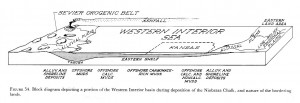One of the most famous formations is the Niobrara Chalk. This formation is exposed in northwest Kansas and southern Nebraska. Formations are sometimes divided into members, subsections of the formation based upon its rock type. The Niobrara Chalk has two members: the lower Fort Hays Limestone and the upper Smoky Hill Chalk. It is the Smoky Hill Chalk which is best known for its fossils.
The sediments that comprise the Niobrara Chalk were deposited in the Western Interior basin during the Late Cretaceous. At that time sea levels rose and the interior of North America was inundated by a shallow sea, the Western Interior Sea. The sea cut North America in half by spreading from the Gulf of Mexico to the Canadian Arctic. Volcanoes to the west, in what is now Utah and Nevada, spewed ash into the sea and sediments eroded from mountains along the western coast were washed into the sea by rivers. What is today Kansas was much closer to the eastern shore of the sea, a low alluvial plain, also gently washing sediment into the sea basin.
The upper member, the Smoky Hill, was deposited from 87 to 82 million years ago, so it preserves a five million year window into the past. Elsewhere we discussed that the Cretaceous sea had a wealth of planktonic organisms. Many of those organisms had calcium carbonate-based shells and body parts, which furnished a steady supply of material to sink to the sea floor. The consistent supply of sediment, both from land and sea, and conditions at the sea floor allowed for the excellent preservation of animals. Those that died and sank to the bottom were rapidly covered by the rain of sediment and entombed until today.
And the diversity of organisms preserved is amazing. In almost every museum with fossils that I have been in, I recognize fossils from Kansas. Giant marine reptiles (mosasaurs and plesiosaurs), flying reptiles (pterosaurs), great toothy fishes, large turtles, and toothed diving birds have all been found. Each of these groups has a very interesting story to share, and we will explore many of them here. An extensive website on fossils from the Niobrara Chalk can be found at OceansofKansas.com.
